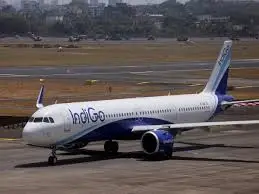IndiGo to be first carrier to operate from Navi Mumbai airport, starting with 18 daily flights

IndiGo’s Strategic Expansion
IndiGo’s decision to begin operations at NMIA reflects its commitment to maintaining market leadership while meeting rising demand for air travel. By expanding into Navi Mumbai, the airline not only strengthens its network but also helps reduce pressure on the already saturated Chhatrapati Shivaji Maharaj International Airport (CSMIA).
Moreover, this move offers passengers from Navi Mumbai, Panvel, Thane, and Pune an accessible alternative, thereby improving convenience and reducing travel time.
Navi Mumbai International Airport: A Game Changer
Developed by the Adani Group, NMIA represents one of India’s largest infrastructure projects, with an estimated investment of $2.1 billion. The airport is expected to transform Mumbai’s aviation landscape with:
- 20 million passengers per year in its initial phase
- 90 million annual capacity over the next decade
- Two parallel runways and three interconnected terminals
As a result, NMIA will play a crucial role in meeting the future air travel needs of India’s financial capital and beyond.
Planned Launch and Operational Readiness
Authorities plan to begin passenger operations after the 2025 monsoon, most likely during the winter schedule. Importantly, IndiGo successfully conducted a validation flight on December 29, 2024, using an Airbus A320. This test flight verified critical systems and marked a significant step toward obtaining final approvals from the Directorate General of Civil Aviation (DGCA).
With this milestone achieved, the airport is now on track to meet its operational goals within the expected timeline.
Initial Route Network and Connectivity
IndiGo intends to operate 36 aircraft movements per day (18 departures and 18 arrivals), initially connecting passengers to a mix of major metros and regional cities. Although the final list of destinations is yet to be confirmed, officials have stated that travelers can expect broad national coverage from day one.
Consequently, passengers will gain better access to key cities without the need to transit through the increasingly crowded Mumbai International Airport.
Competitive Interest from Other Airlines
While IndiGo leads the way, other budget carriers—such as Air India Express, SpiceJet, and Akasa Air—have also expressed interest in shifting part of their operations to NMIA. Over time, this migration is likely to create a dual-airport system, much like those in Delhi, New York, or London.
Therefore, the Navi Mumbai airport is not just an expansion; it is the foundation of a new era for air travel in Western India.
Conclusion: A Transformative Step for Indian Aviation
IndiGo’s initiative to launch operations at NMIA highlights the airline’s strategic foresight and adaptability. Furthermore, the airport’s launch promises to redefine air travel in Mumbai, reducing congestion, improving service quality, and driving regional economic growth.
As other carriers prepare to follow, and infrastructure developments progress steadily, NMIA stands poised to become India’s next great aviation hub.






